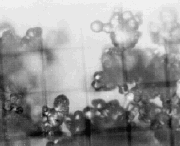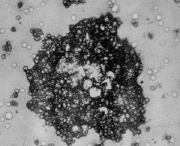|
November-December
1998 |
November-December 1998, Vol. 86, No. 6
The Mystery of Cloud Electrification
  
Figure 6. Graupel-particle growth can be simulated in the laboratory, as shown in this photograph of a particle 300 micrometers across (left). The sample was grown in a wind tunnel from supercooled cloud drops 10 to 20 micrometers in diameter, which are visible as frozen individual drops on the particle. Different geometries of accretion and freezing are evident in this example; a few of these cause symmetrical freezing from top and bottom, leading to shattering of the drop. (Photomicrograph by Ya Yi Dong.) Particles can be collected by aircraft penetration of a cloud, in this case (middle) at the -8-degree level of a Florida thunderstorm. At the center is a pristine vapor-grown secondary-ice column. A graupel particle (right) and the cloud droplets from which it is growing can be seen in this photomicrograph of a sample collected by aircraft penetration of a Montana thunderstorm. (The last two images are of plastic replicas.) Charge separation develops where ice crystals collide with graupel growing by accretion of supercooled cloud droplets and then bounce off.
|